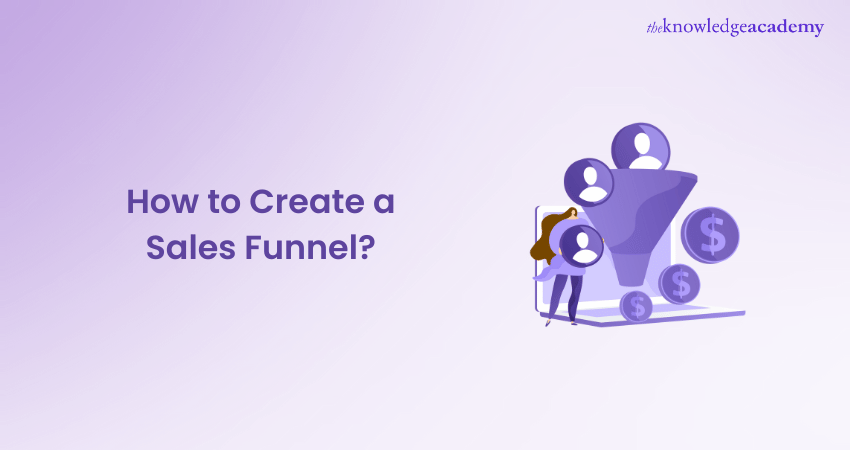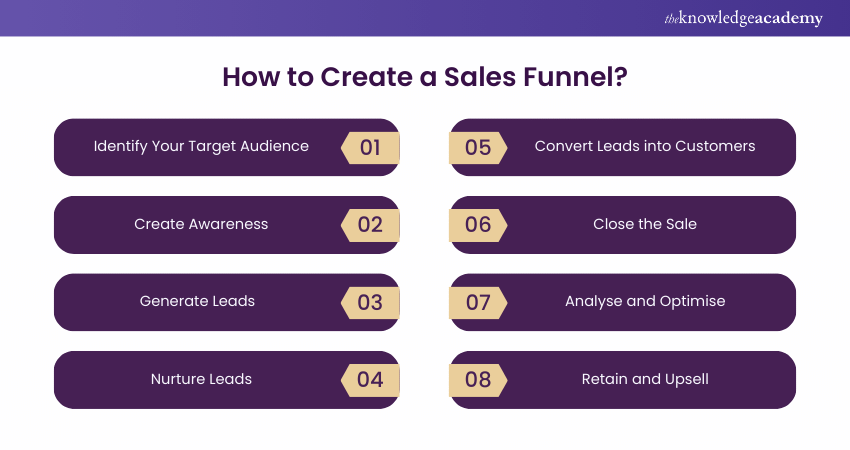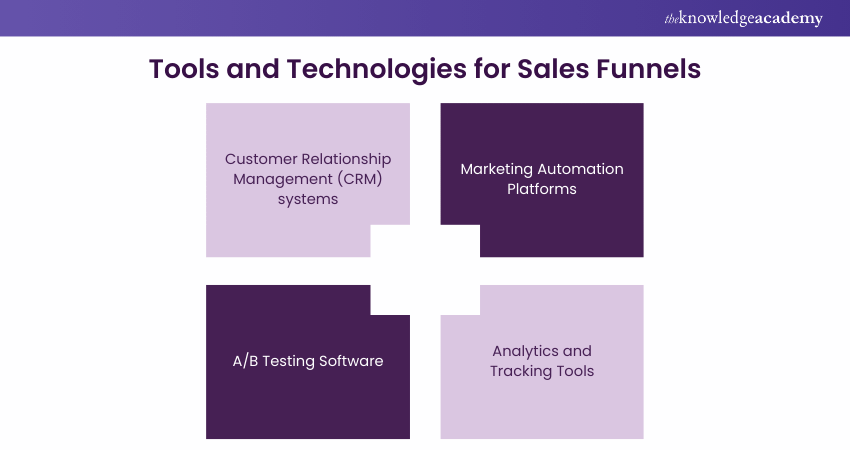We may not have the course you’re looking for. If you enquire or give us a call on +852 2592 5349 and speak to our training experts, we may still be able to help with your training requirements.
We ensure quality, budget-alignment, and timely delivery by our expert instructors.

Imagine a funnel wide at the top to capture potential customers and narrowing down to conversions at the bottom. This is essentially what a Sales Funnel represents. Understanding How to build a Sales Funnel is crucial for businesses to effectively guide customers through the buying journey.
This blog will delve into How to Create a Sales Funnel, its various stages, strategies to optimise each stage, and tools to track performance. Let's explore how to create a high-converting Sales Funnel that drives business growth.
Table of Contents
1) Understanding what is a Sales Funnel
2) How to Create a Sales Funnel?
3) Application of Tools and Technologies for Sales Funnels
4) Measuring and Analysing Sales Funnels
5) Optimising and Refining Your Sales Funnel
6) Conclusion
Understanding What is a Sales Funnel
A Sales Funnel is a structured framework that outlines the journey a potential customer takes from becoming aware of a product or service to making a purchase decision. It represents the various stages a prospect goes through, starting with discovering a brand and culminating in becoming a paying customer. This metaphorical “funnel” symbolises the gradual narrowing of the customer base as they move through distinct stages, reflecting the reduction in numbers as some prospects drop out at each phase.
The Sales Funnel consists of several stages, including awareness, interest, consideration, intent, purchase, loyalty, and advocacy. At the awareness stage, individuals become aware of a brand’s existence. Interest is generated as they learn more about the offerings. Consideration involves evaluating options, leading to an intent to purchase. Subsequently, a decision is made, resulting in a purchase.
How to Create a Sales Funnel?
Crafting an effective Sales Funnel is a strategic process that needs a deep understanding of your target audience and their journey. By following these instructions, you can create a funnel that maximises conversions and drives business growth.

1) Identify Your Target Audience
a) Conduct Market Research: Use surveys, focus groups, and industry reports to gather data about your potential customers' demographics, interests, and challenges.
b) Create Buyer Personas: Develop detailed profiles of your ideal customers, including their goals, obstacles, and purchasing behaviour, to better understand their needs and preferences.
c) Analyse Competitor Audiences: Study the target audiences of your competitors to identify gaps and opportunities in the market that you can address.
2) Create Awareness
a) Content Marketing: Utilize content marketing to publish blog posts, infographics, and videos that address topics relevant to your audience, attracting visitors and establishing your brand's authority.
b) Social Media Advertising: Run targeted ad campaigns on platforms like Facebook, LinkedIn, or Instagram to reach your audience where they spend their time online.
c) Search Engine Optimisation (SEO): Optimize your website and content with relevant keywords as part of your SEO strategy to improve your search engine rankings and drive organic traffic.
Ready to transform your sales approach? Get started with our Sales Training and see the difference!
3) Generate Leads
a) Lead Magnets: Offer valuable resources like eBooks, whitepapers, or free trials in exchange for contact information to attract potential leads.
b) Landing Pages: Create dedicated landing pages with clear calls-to-action (CTAs) and forms to capture visitor information and convert them into leads.
c) Webinars and Events: Host webinars or virtual events that provide valuable insights and engage your audience, encouraging them to sign up and become leads.
4) Nurture Leads
a) Email Marketing: Utilize email marketing to send personalized follow-up emails with relevant content, offers, and updates to keep leads engaged and move them further down the funnel.
b) Content Drip Campaigns: Implement automated email sequences that deliver educational and valuable content over time, helping to build trust and maintain interest.
c) Retargeting Ads: Use retargeting ads to remind leads of your products or services as they browse other websites, keeping your brand in their consideration set.
5) Convert Leads into Customers
a) Personalised Offers: Present tailored offers based on the lead's interests and behaviour, making your proposition more appealing and relevant.
b) Product Demos and Trials: Provide free demos or trials to allow leads to experience your product firsthand, addressing their concerns and proving its value.
c) Sales Consultations: Offer one-on-one consultations to answer questions, address objections, and guide leads through the decision-making process.
6) Close the Sale
a) Streamlined Checkout Process: Ensure a smooth and easy purchasing process with clear instructions, minimal steps, and multiple payment options.
b) Excellent Customer Support: Provide responsive and helpful support to assist customers with any issues or questions during their purchase.
c) Clear Value Proposition: Reinforce the benefits and value of your product or service to reassure customers and confirm their decision to buy.
7) Analyse and Optimise
a) Track Metrics: Monitor Key Performance Indicators (KPIs) like conversion rates, cost per lead, and customer acquisition cost to evaluate funnel effectiveness.
b) A/B Testing: Conduct A/B tests on different elements of your funnel, such as CTAs or landing page designs, to determine what works best for your audience.
c) Gather Feedback: Collect feedback from leads and customers about their experience with the funnel to identify areas for improvement and make data-driven adjustments.
8) Retain and Upsell
a) Customer Loyalty Initiatives: Implement loyalty initiatives to reward repeat customers and encourage continued engagement with your brand.
b) Personalised Recommendations: Use purchase history and customer data to offer personalised product recommendations and upsell opportunities.
c) Regular Follow-ups: Stay in touch with customers through email newsletters and exclusive offers, maintaining the relationship and promoting additional products or services.
Elevate your Sales game with our Sales Analytics Training by unleashing data-driven strategies for unparalleled success!
Application of Tools and Technologies for Sales Funnels
In the digital age, creating and managing Sales Funnels has been greatly facilitated by a plethora of tools and technologies. These resources empower businesses to streamline their processes, analyse data, and optimise their strategies. Here's a closer look at the essential tools for building and refining your Sales Funnel:

Customer Relationship Management (CRM) systems
A CRM system is the cornerstone of managing customer interactions and relationships. It enables you to store customer data, track communication, and gain insights into their behaviours:
1) Data Organisation: Store and manage customer information, interactions, and purchase history in a centralised platform.
2) Segmentation: Categorise customers based on various attributes, allowing for more targeted marketing efforts.
3) Automated Communication: Send personalised emails and messages based on customer actions and preferences.
Marketing Automation Platforms
Marketing automation tools help you streamline repetitive tasks and deliver consistent messaging across different stages of the Sales Funnel:
1) Email Campaigns: Create automated email sequences that nurture leads and guide them through the funnel.
2) Lead Scoring: Assign scores to leads depending on their interactions, indicating their readiness for conversion.
3) Drip Campaigns: Send a series of timed messages to gradually educate and engage prospects.
Analytics and Tracking Tools
Data-driven Decision-making is critical in Sales Funnel optimisation. Analytics tools provide insights into user behaviour and funnel performance:
1) Conversion Tracking: Monitor the entire funnel's performance, identifying where users drop off and where they convert.
2) Traffic Sources: Determine which channels are driving the most traffic and conversions to adjust your strategies accordingly.
3) Behavioural Analytics: Understand how users interact with your content and site, helping you refine your messaging and design.
A/B Testing Software
A/B Testing involves comparing two versions of a webpage or email in order to see which one performs better. This tool helps in refining your Sales Funnel components:
1) Landing Pages: Test different headlines, images, and CTAs to identify what resonates most with your audience.
2) Email Content: Experiment with different subject lines, content styles, and offers to maximise open rates and click-throughs.
3) User Experience (UX) Elements: Test variations in layout, colours, and design elements to optimise user engagement.
Utilising these tools strategically can transform your Sales Funnel into a finely-tuned system that consistently converts leads into loyal customers. They empower you to make informed decisions, automate processes, and create a seamless customer experience throughout the entire journey.
Master the art of Sales negotiation for lasting business success with our Sales Negotiation Training. Sign up now!
Measuring and Analysing Sales Funnels
In the world of Sales and marketing, measuring and analysing the effectiveness of your Sales Funnel is not just a recommended practice—it's essential. Accurate measurement provides valuable insights that guide your decisions, helping you identify strengths, weaknesses, and areas for improvement. Here's a closer look at how to effectively measure and analyse your Sales Funnel:
Key Performance Indicators (KPIs)
Identifying and tracking relevant KPIs is crucial for evaluating the health of your Sales Funnel:
1) Conversion Rate: Measure the percentage of visitors who successfully move from one stage to the next.
2) Bounce Rate: Track the proportion of visitors who leave your site without engaging further.
3) Average Order Value: Calculate the average amount spent by a customer during a transaction.
4) Churn Rate: Monitor how many customers you lose over a specific period.
Tracking Conversions and Drop-offs
Understanding exactly where users drop off in the Sales Funnel can help pinpoint areas that need improvement:
1) Conversion Funnel Tracking: Map out the entire Sales Funnel and identify stages where users tend to exit.
2) Exit Pages: Analyse the pages where users frequently exit your site to determine if there are issues with those pages.
3) Abandoned Cart Analysis: Examine reasons why users abandon their shopping carts during the purchase stage.
Analysing Customer Behaviour
Gaining insights into how users engage with your content and website is essential for refining your strategies:
1) Heatmaps: Visualise where users click, move, and scroll on your webpages to understand their browsing behaviour.
2) Session Recordings: Watch recordings of user sessions to identify pain points, confusion, or areas of interest.
3) Time on Page: Measure how much time users spend on each page to gauge content engagement.
By systematically measuring and analysing these aspects, you can make informed decisions about where to optimise your Sales Funnel for better results. Regularly reviewing your KPIs and tracking user behaviour allows you to adapt to evolving customer needs and preferences, ensuring that your Sales Funnel remains effective over time.
Unlock the art of closing deals with our cutting-edge Closing Sales Technique Masterclass. elevate your Sales game today!
Optimising and Refining Your Sales Funnel
A Sales Funnel is not a static entity; it's a dynamic process that requires continuous evaluation and improvement. Optimising and refining your Sales Funnel is the key to enhancing conversion rates, customer satisfaction, and overall business success. Here's how you can systematically optimise and refine your Sales Funnel for optimal results:
Identify Bottlenecks
Pinpointing areas of friction or drop-offs in your funnel is the first step towards optimisation:
1) Analyse Data: Use analytics tools to identify stages where users are leaving the funnel or not progressing as expected.
2) User Feedback: Gather feedback through surveys, interviews, and customer support interactions to uncover pain points.
3) A/B Testing: Experiment with variations of content, CTAs, and designs to identify what resonates better.
Use A/B Testing and Experimentation
A/B testing involves comparing different versions of elements in your funnel to determine what works best:
1) Landing Pages: Test different headlines, images, and layouts to find the most effective combination.
2) CTAs: Experiment with different wording, colours, and placements to increase click-through rates.
3) Email Campaigns: Test subject lines, content, and sending times to maximise open and conversion rates.
Personalise and Customise
Tailoring the user experience (UX) based on individual choices and preferences can significantly improve engagement:
1) Segmentation: Segment your target audience into groups based on demographics, behaviours, or preferences for more targeted messaging.
2) Dynamic Content: Display different content or offers based on a user's previous interactions with your brand.
3) Personalised Recommendations: Provide product or content recommendations based on user history and preferences. By focusing on optimisation and refinement, you can create a Sales Funnel that adapts to your audience's needs and evolves with industry trends. Regularly analysing data, experimenting with new strategies, and embracing personalisation can lead to increased conversions, better customer experiences, and ultimately, greater business success.
Elevate your Sales expertise with our Sales Management Training by empowering your team and transforming your results!
Conclusion
To sum it up, a well-crafted Sales Funnel is the compass guiding potential customers towards loyal advocacy. Master each stage, wield technology wisely, and analyse with precision. Adapt, refine, and let customer insights steer your course. As you navigate this transformative landscape, remember that a successful Sales Funnel isn't just a journey—it's a strategic evolution propelling your business to new heights of engagement and growth. Hope we could answer all your queries about “How to Create a Sales Funnel”!
Frequently Asked Questions
How is a Sales Funnel Different From a Marketing Funnel?

A Sales Funnel focuses on converting leads into customers through direct sales tactics, while a marketing funnel is designed to attract and engage prospects, building awareness and interest before passing leads to sales for conversion.
What is a Sales Funnel Manager?

A Sales Funnel Manager oversees the development and optimisation of Sales Funnels, ensuring each stage effectively converts prospects into customers. They analyse performance, refine strategies, and implement improvements to enhance overall sales effectiveness and revenue generation.
What are the Other Resources and Offers Provided by The Knowledge Academy?

The Knowledge Academy takes global learning to new heights, offering over 3,000 online courses across 490+ locations in 190+ countries. This expansive reach ensures accessibility and convenience for learners worldwide.
Alongside our diverse Online Course Catalogue, encompassing 19 major categories, we go the extra mile by providing a plethora of free educational Online Resources like News updates, Blogs, videos, webinars, and interview questions. Tailoring learning experiences further, professionals can maximise value with customisable Course Bundles of TKA.
What is The Knowledge Pass, and How Does it Work?

The Knowledge Academy’s Knowledge Pass, a prepaid voucher, adds another layer of flexibility, allowing course bookings over a 12-month period. Join us on a journey where education knows no bounds.
What are the Related Courses and Blogs Provided by The Knowledge Academy?

The Knowledge Academy offers various Sales Training Courses, including the Sales Negotiation Training, Sales Management Training and the Value Based Selling Training. These courses cater to different skill levels, providing comprehensive insights into the Sales Process.
Our Business Skills Blogs cover a range of topics related to Sales, offering valuable resources, best practices, and industry insights. Whether you are a beginner or looking to advance your Sales skills, The Knowledge Academy's diverse courses and informative blogs have got you covered.
Upcoming Digital Marketing Resources Batches & Dates
Date
 Sales Bootcamp
Sales Bootcamp
Fri 7th Mar 2025
Fri 23rd May 2025
Fri 18th Jul 2025
Fri 12th Sep 2025
Fri 12th Dec 2025






 Top Rated Course
Top Rated Course



 If you wish to make any changes to your course, please
If you wish to make any changes to your course, please


